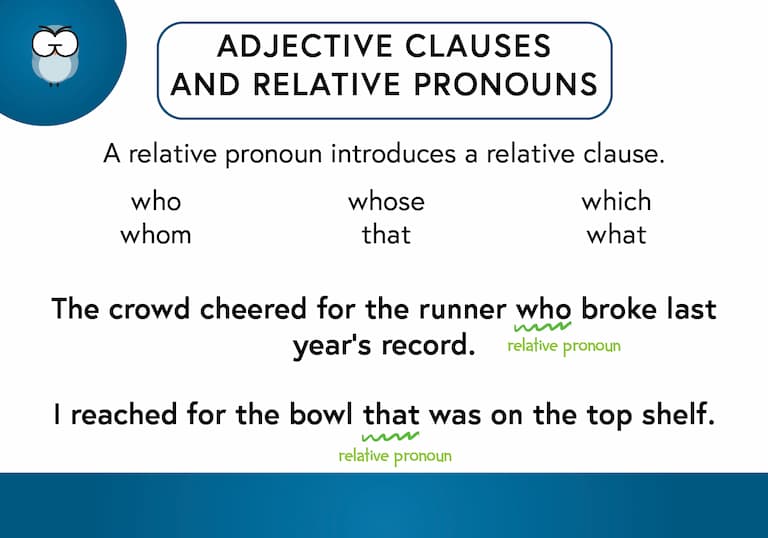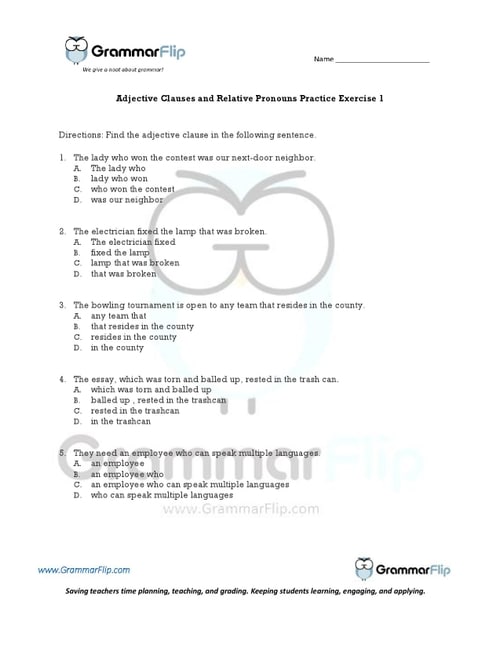What is a Relative Pronoun?
A relative pronoun is a type of pronoun that introduces a relative clause, and a relative clause is a dependent clause that provides additional information about a noun in the main clause of a sentence. The following words are relative pronouns: who, whom, whose, that, which, what.
Some examples of relative pronouns (introducing adjective clauses) would be the following:
The crowd cheered the runner who broke last year’s record.
Her favorite homemade cookies, which have been awarded many prizes, have the perfect balance of chocolate and peanut butter.
Shandra, whose essay won first place, will attend our local college in the fall.
The class president will be Jerome, whom we met last summer at camp.
I reached for the bowl that was on the top shelf.
Long-Form Videos: Relative Pronouns
Long-form instructional video lessons allow students to engage with grammar concepts in more depth and detail.
This format provides students with a stronger foundation and a more comprehensive understanding of relative pronouns.
Short-Form Videos: Relative Pronouns
Short-form videos are an excellent way to review grammar concepts. Our two-minute instructional videos help students review the concept of relative pronouns to further solidify their understanding.
Definition Cards: Relative Pronouns

Definition cards reinforce grammar concepts by providing clear and concise explanations that students can easily reference for quick review and better retention. GrammarFlip’s definintion cards help students review the concept of relative pronouns to further solidify their understanding.
Why You Should Use Relative Pronouns in Your Writing
Because relative pronouns introduce dependent clauses that provide additional information about a noun in the main clause, there are a handful of relative pronouns that can be used for specific purposes:
Who/Whom – references a person
Which – references an animal or item
What – references a non-living item
That – references a person, animal, or item
The reason we might use these relative pronouns in our writing is to connect ideas that are related and to provide more detail in our writing. Compare the following two sentences:
She was one of the gymnasts.
She was one of the gymnasts who won the gold medal.
Notice how the second sentence with the relative pronoun (and subsequent adjective clause) provides much more insight into the unique aspect of the gymnast (ie, one who won a gold medal – not just any other gymnast).
Finally, be sure not to confuse relative pronouns with relative adverbs which are slightly different.
Download a Free Worksheet on Relative Pronouns!
Click the image below to download your free worksheet on relative pronouns!

Need a grammar program that provides the instruction and grading for you?
Explore More GrammarFlip Lessons!
Parts of Speech lessons provide the building blocks of grammar. GrammarFlip covers these topics in detail to ensure a solid foundation is built. First time learners and students seeking to review the parts of speech can both benefit from the instructional videos and slide show reviews.
Parts of the Sentence lessons are critical for understanding how the parts of speech function in language construction. From the basic to the advanced, these lessons will cover a wide range of grammar topics that can be used in any grade level or classroom.
Mechanics and Usage lessons equip students with the necessary skills to communicate clearly to all audiences. With a focus on the application of these concepts in student writing, these lessons tie together both simple constructions of grammar as well as the more complex such that any age or skill level of student will benefit.


